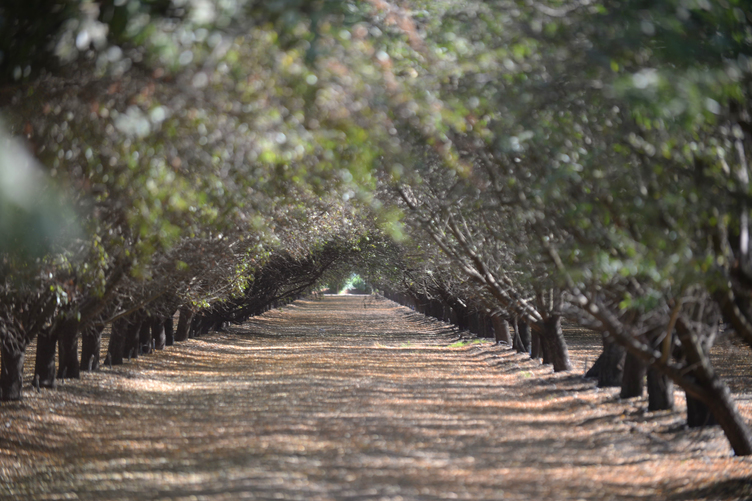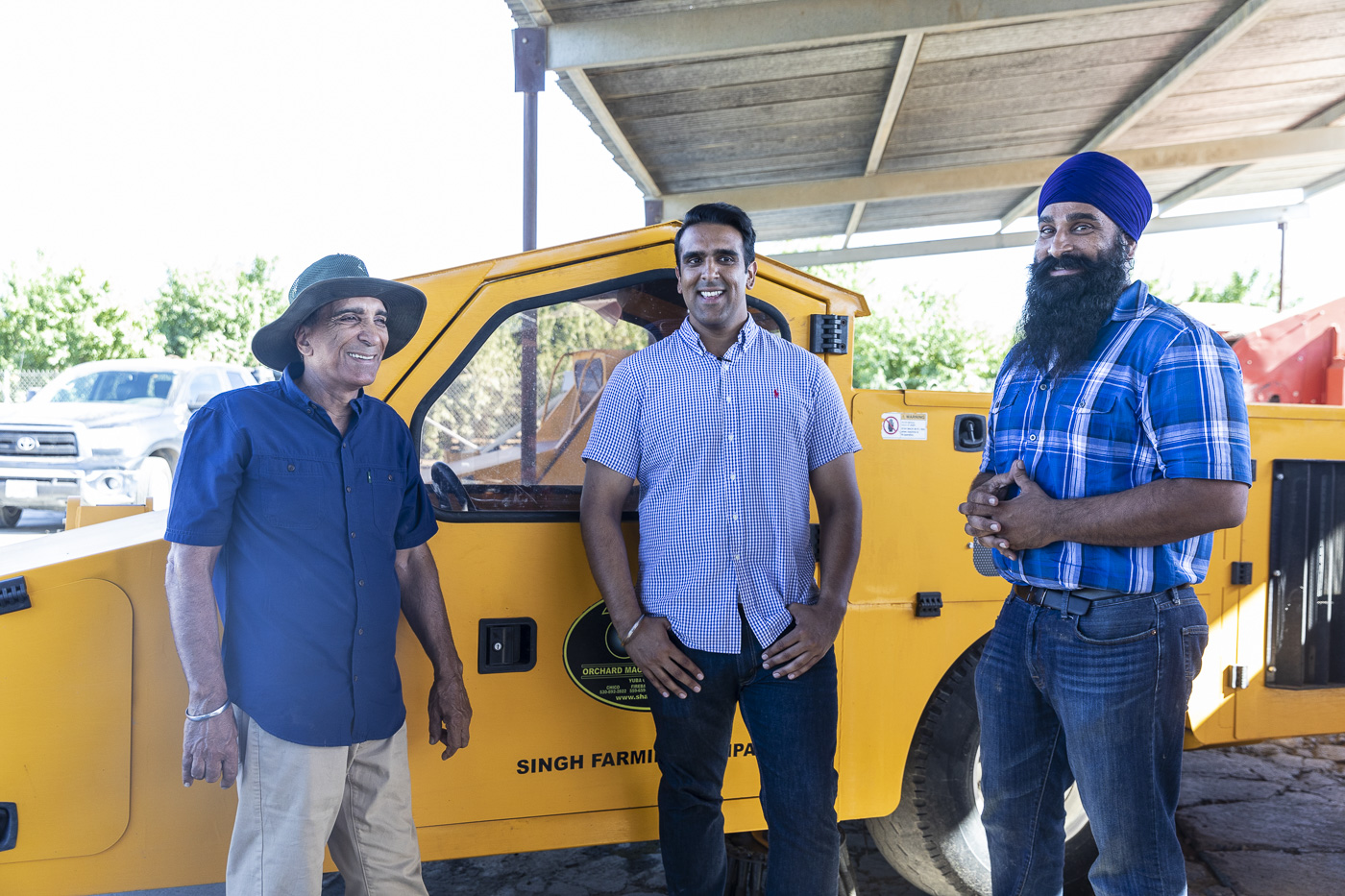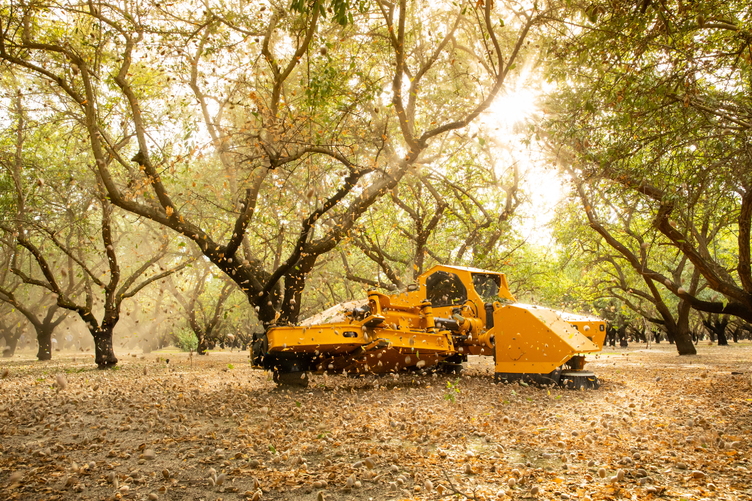
Mallvinder Kahal, operations manager for Kahal Farms in Madera, Calif., said reducing dust at harvest has saved money on labor, decreased wear-and-tear on machinery and reduced harvest passes.
“It is only to your benefit,” Kahal said about adopting best management practices for reducing dust at almond harvest. “It’s not just about being a good neighbor, which is important, it is about being a better farmer.”
Nearly twenty years after the Almond Board of California (ABC) began researching ways to reduce dust at harvest, growers are finding multiple benefits in adopting the recommendations.
ABC began researching ways to reduce dust at harvest in the early 2000s. Findings from that research are driving the recommendations that farmers like Kahal are using today, according to Jesse Roseman, principal analyst of environmental and regulatory affairs for ABC.
“We tested fan speeds, machine speeds, sweeper-head height, wire tines, number of sweeper passes, and even equipment manufacturers contributed and started developing machinery that by design would reduce dust,” Roseman said. “The studies went on for six or seven years.”
In the mid-2010s, ABC shifted its efforts from research to outreach, Roseman said, and growers responded.
“What happened is we got really clear on the research and we really trusted what we were seeing and we had the tool kit. Then we pivoted toward doing more outreach and communicating those results to growers,” Roseman said.
The outreach has included the creation of videos and brochures, meeting presentations and media reports. In 2018, ABC announced a goal of reducing harvest dust by 50 percent by 2025.

Start with a Clean Orchard Floor
Kahal said his dust-reduction program starts after harvest, when the farm removes crowns that settle on orchard floors, and continues through the offseason with weed control. Even prior to harvest, the farm levels orchard floors and fills in holes so nuts don’t get stuck.
“Our big thing is, right off the bat, we make sure the orchard floor is clean,” Kahal said. “That is going to minimize your passes. If you leave nuts behind, you are going to feel obligated to go back and pick up anything left behind and those extra passes are going to create more dust.
“When you have a clean orchard floor, you are working less at harvest,” Kahal said. “And when you are working less at harvest, it turns out you are saving money, and you are reducing dust.”
Calibrating harvest equipment is another important pre-harvest practice, Kahal said. “If you are taking the time to make sure everything is calibrated right, you are putting less wear and tear on your machinery, as well minimizing your passes,” Kahal said. “The actions that disrupt the soil are the same actions that wear out your machinery.”
When calibrating equipment, Kahal said he shoots for “that sweet spot,” where sweeper bristles are not too high, not too low and air pressure is just right.
Too little air pressure, Kahal said, will result in nuts being left behind. Conversely, he said, “If you have too much air pressure and are aggressively scraping the ground, you are blowing dust around and getting more wear and tear on your equipment than is necessary. You want to be in that sweet spot where everything is at the right level, so you don’t leave anything behind, but you also aren’t overly aggressive to where you are chipping away at the soil.”
According to an Almond Board brochure, sweeper heads can be set as high as 0.5 inches off the ground and still do a good job. The Board also recommends growers use wire tines on sweepers, if possible.
Plan Harvest Routes
ABC also recommends that growers devise harvest routes ahead of time in a way that ensures as much dust as possible is blown back into orchards. “Plan your passes and travel direction to direct dust away from roads, homes and sensitive locations, such as schools, hospitals and day-care centers,” states an ABC brochure. The Board also recommends growers consider placing traffic signs at strategic points to warn motorists of harvest activities if harvesting near a busy road.
Going slow during harvest is another ABC recommendation and one Kahal advocates.
“Slowing down will ensure you are going to capture everything you can capture and it can decrease your liability and increase worker efficiency,” Kahal said. “Sometimes you have people working 12-hour shifts, it is hot and fatigue is a problem. Slowing down ensures you get more throughput from your machine operators.
“It is easier said than done,” he continued. “We have been in spots where you need to get things done quickly for a variety of reasons. I understand the urgency. You’ve got to find a steady place between what you consider acceptable efficiency and what you consider a good, methodical process where you aren’t wearing out your machinery, you aren’t creating too much dust, and your guys are working at a sustainable level.”
After harvest, Kahal said he often applies water on orchard perimeters to settle soil. “A lot of the dust you create at harvest makes it to the perimeter and that is where the traffic and air currents can push it around further,” he said. “Throwing water down on that soil is a way for us to capture and contain that dust to our orchards.”
Roseman pointed out that cost-share programs through the USDA’s Natural Resources Conservation Service and San Joaquin Valley Air Pollution Control District, and other incentives are now available that can help growers invest in new machinery designed to reduce dust at harvest.
As part of its effort to reduce dust, the Almond Board of California in recent years also has funded research into off-ground harvesting and nut-drying alternatives—research that is showing promise.
“We see above-ground harvest as a component that is going to help us reach our goal of reducing dust by 50 percent by 2025, but it won’t be just above-ground harvest that enables us to do so,” said Sebastian Saa, senior manager of agricultural research for ABC. “It will be the sum of all the different actions.”
“We feel excited about continuing this journey that started back in the early 2000s with developing best management practices and has since evolved into working together with the San Joaquin Valley Air Pollution Control District to develop incentives and now includes trying to understand how we can harvest almonds without producing even minimal dust.”
Kahal, for one, believes the industry has a real shot at achieving its dust-reduction goal.
“I think we are really fortunate in the almond industry to have a board that is very proactive in trying to provide us the resources and the education on what can be done to reduce dust,” he said. “I absolutely think we can achieve the goal.”
















